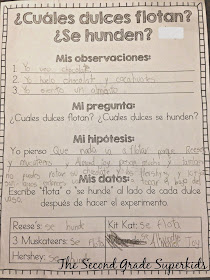For the past week we have been working hard to develop our understanding of the process scientists use to conduct investigations.
We started by watching a short video on Brainpop Español to introduce the Scientific Method.
(Note: It is actually a free video right now (for those who do not have a Brainpop subscription), so get it while it's hot!)
After developing some background knowledge, I highlighted each of the steps of the Scientific Method with the students by creating a flow chart with these adorable little freebie posters from
The students copied down each of the steps as well on this printable I created for them to store in their science folders and utilize throughout the school year.
After the initial lessons with this process, I wanted to gather a bit of information about my students' understanding thus far. So I asked each student to share something that he/she had learned on a Post-It in regards to the steps we will be carrying out as scientists this year in the classroom. We then did an inner/outer circle share activity so that each student had the chance to share/hear the ideas of others. After sharing, the students added their post-its to a class circle map shown below.
Here are a few of their ideas:
Next, it was time to put these steps into action.
With Halloween just a few short weeks away and chocolatey goodness everywhere you turn, I figured why not embrace it in our hands-on effort to understand the process a little better.
I am sure that the whole "sink vs. float" experiment is not a new concept for any of you - it is however, a truly simple one to not only set up, but also introduce students to the steps of the scientific method because it doesn't overwhelm them with new/difficult content at the same time.
Yes, my former science lab of a classroom is quite handy for investigation set up!
Below is the printable that my student's utilized as we walked through each step of the method together in determining which of our favorite Halloween treats sink or float. We completed the investigation in 2 days.
Day 1: Observations, Question, and Hypothesis
Day 2: Experiment, Data Collection/Analysis and Drawing Conclusions
Here are some of their conclusions based on the results:
I absolutely loved hearing/reading their thinking as to why they believed the items either floated or sank. They truly used their schema and observations to draw their conclusions!
At the close of our investigation, we had a quick think-pair-share about what we now understand better about the Scientific Method post-investigation. It was clear my students had further developed their learning, and I look forward to seeing how it continues to grow as we grow as scientists this school year.






















